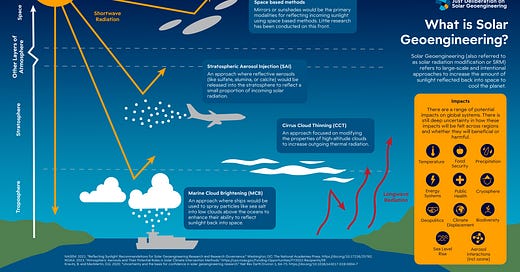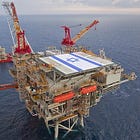Is Israel Going to Tamper with the Climate?
In the first of a new series of update/supplementary articles, this follows on from the Geoengineering piece I recently published.
The Center for International Environmental Law (CIEL), has reported on a US-Israeli initiative to engage in solar geoengineering technology (SG). The company behind it is Stardust Solutions, founded in 2023. As CIEL notes:
the company is “developing and testing” both a particle and a dispersal system and plans to upgrade “the prototype airborne dispersion system to an operational level” enabling “dispersion at the required capacity from a future operational aircraft” in the coming year.
Initial outdoor tests will take place in Israel. CIEL is concerned that this could breach a moratorium on SG:
The Convention on Biological Diversity, which Israel is a party to, issued a series of decisions relating to geoengineering starting in 2008, including a de facto moratorium because of its implications for biodiversity. The moratorium was reaffirmed, by consensus, at CBD COP16 in Colombia last autumn, with Parties citing concern about the increase in outdoor solar and marine geoengineering experiments. While the moratorium has an exemption for small-scale research, a commercial factor is a key aspect of determining whether or not a project meets the criteria for this exemption.
Another key point here is links with the company and the Gaza genocide:
Stardust has received financing from controversial Israeli-Canadian venture capital firm AWZ, which has been accused of profiting from the ongoing genocide in Gaza and has a partnership with the Israeli Ministry of Defense’s Directorate of Defence Research and Development.
The fact that a rogue state such as Israel may be given carte blanch to manipulate the climate through commercial entities, should be of great concern. Before getting into more detail on Stardust, I’m going to dig into an issue I briefly touched on in the original article. The paper Geopolitical ecology of solar geoengineering: from a 'logic of multilateralism' to logics of militarization, published in the Journal of Political Ecology, focuses on the deployment of Stratospheric Aerosol Injection (SAI). This involves spraying sulphur dioxide into the lower stratosphere to reflect solar radiation. The paper reinforces the need to perpetuate the process as background warming would continue, leading to a rapid acceleration if the process were stopped.
As I pointed out in the previous article, there is the danger that such processes could be carried out without international consent. The paper then argues that such experiments are likely to be led by the US, as it fits in with the "logics of militarization," revolving around US strategic hegemony. The paper notes:
SAI is being militarized via involvement of the Department of Defense (DoD) and cognate institutions [This includes U.S. intelligence agencies, defense-oriented think tanks and university institutes, and defense contractors.] in its development, scenarios for deployment reliant on military logics and technologies, and the increasingly prevalent language of "climate intervention" subject to the rules of war.
The Pentagon previously concluded that climate change was a "threat multiplier," see here.
In 2003, the Pentagon published the report ‘An abrupt climate change scenario and its implications for United States national security’. The paper notes that:
The report lists recommendations to the U.S. defense community that include the exploration of "geoengineering options that control the climate", noting that they must be "studied carefully as they have the potential to exacerbate conflict among nations."
NASA picked up the baton in 2006, running a solar geoengineering conference. Then in 2008, the Council on Foreign Relations (CFR), which is closely linked to the the US foreign policy establishment – held a workshop on unilateral geoengineering. DARPA then became involved in SAI in 2009. Various other initiatives followed. Significantly the CIA entered the fray in 2011. The paper notes that:
The CIA put formal resources into exploring solar geoengineering in 2013, initiating and funding a U.S. National Academies study into the scientific, technical, and political aspects of "climate intervention". Military interest continued in 2015 via The Center for Naval Analysis running a series of "climate war games" in Delhi, India with former diplomats and military officers from multiple countries. Solar geoengineering was included as a tactic in these games, and results demonstrated that few peaceful mechanisms exist to stop determined unilateral deployment.
The paper picks up on Harvard’s involvement in geoengineering research, which I covered in the previous article, noting links with the defence and intelligence community. Also mentioned is counter-geoengineering, whereby a country that is against SAI can potentially utilise CG as a deterrent.
The paper goes on to discuss how the US dominated the oil market in the Middle East during the post war era, linking the flow of oil to the dollar - "petrodollars". This became inextricably linked to US hegemony. Changes though during the 1980s challenged the status quo:
OPEC and financialization wrested direct power over production and pricing from Western oil majors, disrupting a key component of the "American system", necessitating more coercive measures via U.S. imperial intervention. As Jones (2012: 210) argues, American "oil wars" – particularly since the Carter Doctrine of 1980 – have "not been about establishing direct control over oil fields nor about liberation" or freedom; rather, "keeping prices stable (not low) and keeping pro-American regimes in power were central to U.S. strategic policy." This required a geostrategic reconfiguration of the region via the creation of U.S. Central Command in 1983, which key military officials openly link to U.S. imperialism, the flow of oil, and global capitalism: "…the Central Region has continued to grow in importance … Maintaining stability in this volatile region is key to the free flow of oil and other commerce essential to the world economy".
Also linked to this is US arms trade in the region, cementing the fossil-fuel-military-industrial-complex. The Iraq war played role in consolidating US power. It also led to increased production at home. The paper notes:
With Western, dollar-denominated, militarized control over a key oil and gas producing region, and a commanding position in domestic oil and gas production, U.S. geopolitical strategy is fundamentally predicated on maintaining the centrality of oil and gas in global capitalism, and maintaining the oil-dollar regime by keeping China, the wider East Asian region, and other allies fundamentally dependent on imported oil – from the U.S. and Middle East sources – for the foreseeable future.
However this may change, with China pushing for an alternative to the dollar, not to mention the expansion of renewables. How this plays out remains to be seen, but the signs are that the US will attempt to challenge China militarily. This then pulls in the real reason why the US is interested in SAI, basically to buy time and, ‘to slow and manage climate and energy transitions in the interest of the U.S. hegemonic position undergirding global capital.’
I cover the story of middle East oil here.
Under the logic of Full-spectrum dominance, where the US would be in ‘"command of the commons" – air, sea, space and cyberspace’, this is where the use of SAI would be of strategic importance, with the US dominating its use and using force to counter any challenge if necessary. As the paper notes:
If the U.S. military is systematically enrolling the stratosphere into strategic operations, any form of SAI deployment would – at the very least – likely require clearance by DoD, if not outright control to ensure continuity of strategy across the stratospheric commons.
The paper sums up noting its:
analysis suggests that forms of "planetary sovereignty" will not necessarily require entirely novel political configurations, but could emerge via existing forms of imperial intervention written into the structures of international law. Solar geoengineering and the geopolitical ecologies of climate intervention are immanent to the structures of global capitalist geopolitics – not extreme aberrations – and intimately bound up with questions of world hegemony, control of energy, financial flows, and military-imperial dominance. Scenarios for unilateral SAI deployment need to take these processes into account.
This begs the question as to how Stardust fits into the wider equation. Undark presents more background to the story. Stardust is based in Israel, but incorporated in the US. What makes Stardust stand out is that as a private company, it will drive the initiative as opposed to a science led approach based at a University. The company has been very discrete about its operations, but its aim appears to be to sell the process to governments planning to modify the climate, ‘acting like a kind of defense contractor for climate alteration.’ There has been calls for greater transparency, but this seems to be par for the course for Israeli entities. There are echoes here of Israel’s nuclear program, see here.
Indeed, as the article notes, the company has links with the nuclear industry:
The company is led by CEO and cofounder Yanai Yedvab, a former deputy chief scientist at the Israel Atomic Energy Commission, which oversees the country’s clandestine nuclear program.
Other notable people are:
Chief product officer Amyad Spector, a physicist and a former employee of the Israeli government’s nuclear research program; and lead scientist Eli Waxman, an astrophysicist at the Weizmann Institute of Science who formerly served as Spector’s academic supervisor.
Stardust plans to implement SAI with with a proprietary aerosol particle that little is known about. There’s been no public consultations for any outdoor field tests conducted by Stardust. Then there’s the connection of SAI with the Pentagon (see above):
Some of the first geoengineering papers in the late 1990s came from institutions with Pentagon ties, like Lawrence Livermore National Lab and the Hoover Institution. High-profile geoengineering meetings with the George W. Bush administration and the Council on Foreign Relations, as well as a mention in a Department of Defense report soon followed, and the CIA reportedly funded the first geoengineering report from the National Academies of Sciences, Engineering, and Medicine.
According to Stardust, it has no connections with the Israeli Defense Ministry or the Government. However, concerning AWZ, who’s funding to Stardust amounts to around $15 million:
Awz’s partners and strategic advisers have strong ties to Israeli military and intelligence agencies, including former senior directors of agencies like the Mossad, Shin Bet, and Unit 8200, as well as of the CIA and FBI, according to its website. Awz also invests in AI-based surveillance and security tech in Israel, such as through the company Corsight, which has provided facial recognition tech for Israel’s war in Gaza.
As far as ARIA is concerned, which I covered in the previous article, they don’t appear to be engaged directly in any defence related initiatives. However a rather curious post appeared on the Linkedin page of the British Embassy Israel*. It states:
We are so excited about Advanced Research and Invention Agency. Applications are open for Programme Directors.
It then provides a link for prospective applicants. Why the British Embassy in Israel should raise this is unclear. It would certainly require further investigation.
Israel’s track record is crystal clear. They have demonstrated a total disregard for international law, conventions and agreements. What’s to stop the country from deploying geoengineering to impact other countries. We’ve already seen how devastating the deployment of the Stuxnet worm was to Iran’s nuclear program, which I covered in the ‘Open Secret’ article. With this cyber attack, Israel didn’t have to fire a shot. From the evidence presented above, there does appear to be a strong likelihood that geoengineering could have a military application, within the context of preserving US hegemony, with Israel as the right hand man. And Israel's unprovoked aggression against Iran seems to fit in with the geopolitics outlined above.
This is an issue that needs to be monitored closely. Although with Donald Trump in the White House and the purge of anything vaguely resembling environmental protection, who knows where this might be headed.
*Footnote
I’ve sent an email to the Foreign, Commonwealth and Development Office (FCDO), querying this. I’ll update when (and if) I get a reply.








